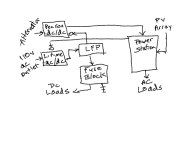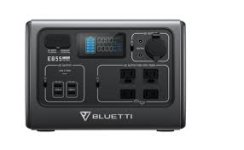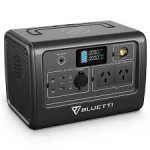So if my solar is plugged to the power station, it will automatically charge the LFP battery? And the power station will recharge from the LFP battery itself? I don’t understand how this is managed?
How do you connect the power station to a LFP battery?
I watched YouTube videos where they connect the LFP to the PS inputs and it recharges it but then the LFP does not charge from the PS so I don’t get how this work. Do you need to manually switch and plug the LFP to the PS input or output depending if you want it to charge or to be charged?
Also, for the main power station I have a hard time finding something.
I have 2 solar panels in parallel 265W each. they are 30V 8.xA panels so total output is 30V 16 amp.
The growatt 12-60V input is good but at 30V it only max out at 10 amps so that doesn’t work.
Same thing with the Dabbson. One of the mentioned Blueti doesn’t have 30A DC, the other one has slow AC charging. The oupes is same as the others.
The Pecron lower input voltage is too high.
I don’t know which battery can I use that can take at least 15 amps at 30V, and has a 30A DC output.
People criticize Goalzero but the Yeti 1500X is super old yet was the first with 30A out, and seems like the only one taking up to 50A solar in, which so far seems the only brand that can work with my solar configuration. I just don’t want to buy a non LFP. All those newer batteries promising so much solar input but if you don’t max out the voltage their current input is ridiculously low.
If anybody knows a station that has 30A DC out, can take 30V @15amp solar input, LFP tech, fast charging and all the standard features, please let me know. I only see the Yeti 4000 pro (too big). Thus why I wish they released an updated 1500 pro already. They might be expensive but at least they have proper inputs and outputs and functionality unlike all that Chinese crap that looks good on paper but doesn’t work in the real world for a lot of configurations.
Yes, you have to switch the LFP around on the powerstation depending on if you want to charge the LFP or use it as an expansion battery to charge the powerstation. It's just two cords though, just plug in one or the other, simple. I should draw a picture or make you a video showing the wires and swap but it's late, will try to use the words

So I have a Pecron e1500LFP, you sound familiar. When I go on a trip, I just toss the powerstation and a 100Ah 12.8v Redodo mini Lifepo4 battery in the truck, we'll call that the LFP, it has 1280 Watt-hrs. Both are charged up.
6 AWG = 70A
8 AWG = 40A
10 AWG = 30A
The flow into and out of my LFP will be 30A max.
Discharging LFP, used as expansion battery:
Hooked onto my LFP, I have a dongle of 6AWG to a male XT60 30A plug.
I have a patchcord of 10 AWG with a 5521 male on one end, to plug into the Pecron SCC MPPT 12-18V 100W input. The other end has a female xt60, that I can connect to the LFP Xt60 dongle. This will recharge my powerstation at 100W, 12.5 hours to put 1250 Watt-hrs in, just let it sit overnight if needed.
Battery 6awg dongle is 70A, patchcord is 30A, e1500LFP 5521 input has internal limiter for 100W i.e. 9A, so cords protected.
Charging the LFP:
SEVERAL WAYS
From Powerstation, if I am charging powerstation from 120V shore power, or from solar PV panels, or even will do so later:
1. from e1500LFP 30A 13.4 V dc output. Nominally 12V, but EXCELLENTLY actually 13.4! This lets you recharge a 12v LFP to 85%. I just plug the LFP dongle into my e1500LFP 30A xt60 female output. Pecron limits output to 30A via internal fuse, so my 6AWG battery dongle which can do 70 is protected. This is 400 W charging, and is more efficient than AC if I am charging the e1500LFP via solar, no waste. I use this if I'm going to use solar to recharge Pecron, and an 85% LFP recharge is fine.
2. From e1500LFP 120V outputs. I have a Victron IP67 25A battery charger, with a female xt60 plug. I plug that into the Pecron, other end into LFP dongle, recharges LFP at 25A self limited, cords protected. This is 85% efficient via Pecron inverter, which just doesnt matter if I'm plugged into 120V ac shore power, so I use it. This is 350W or so, but will recharge LFP to 100%.
3. I can also just plug the victron ip67 charger into shore power if I wanted, but just going to the e1500LFP instead is easier, it lets me use the Pecron pass thru power and shore power recharges both LFP and Pecron at once.
So simple: either plug LFP into Pecron INPUT dongle, or plug it into Pecron OUTPUT port or Victron charger output port.





